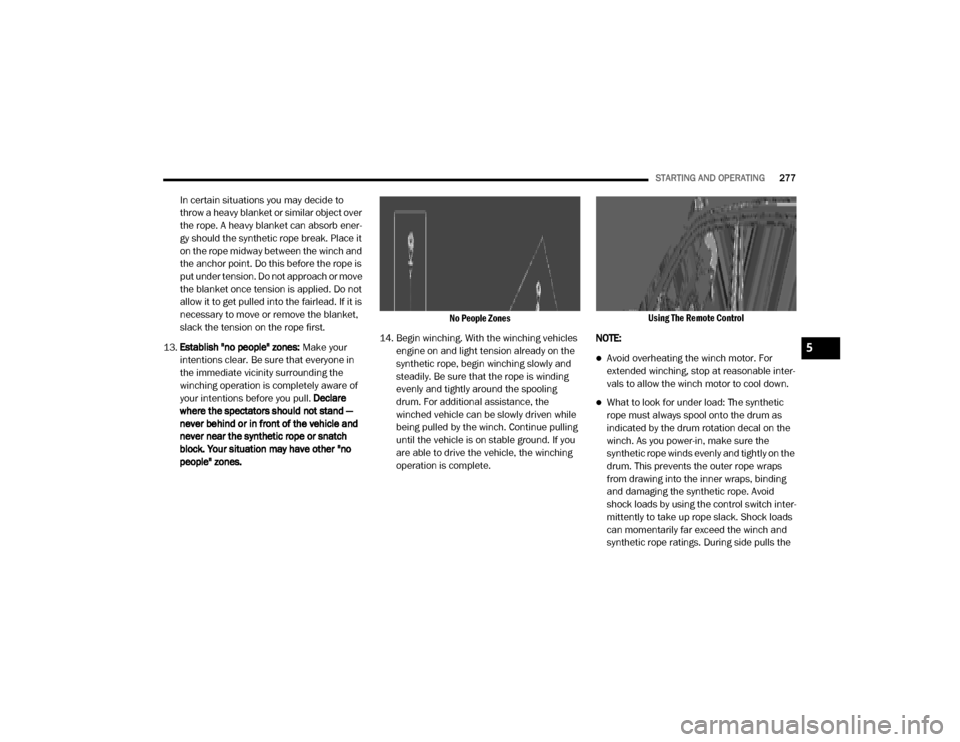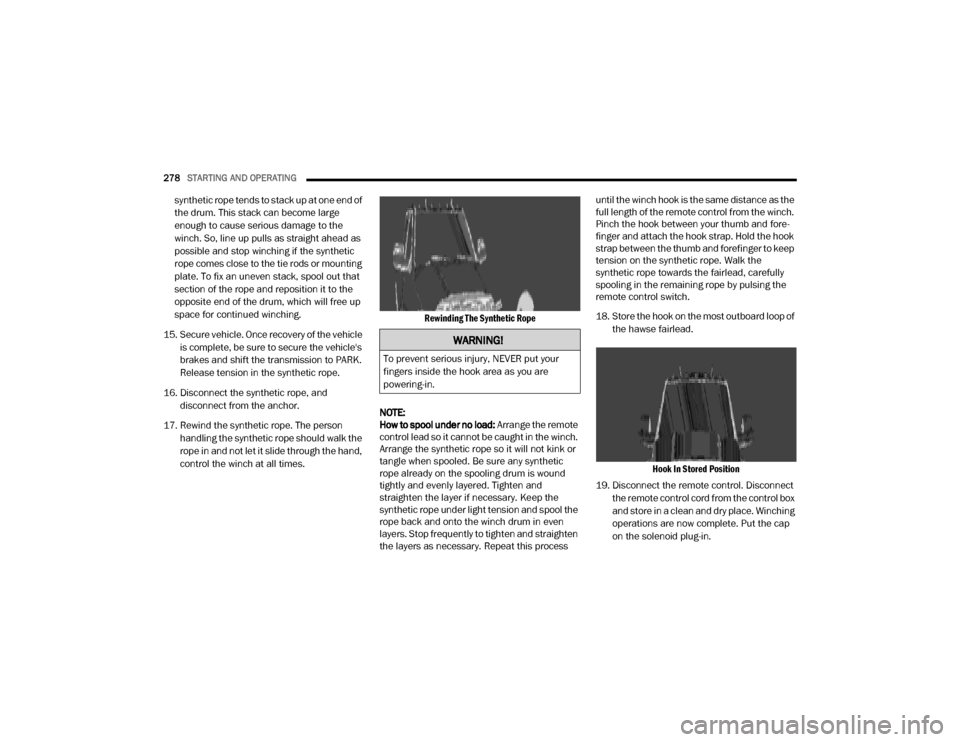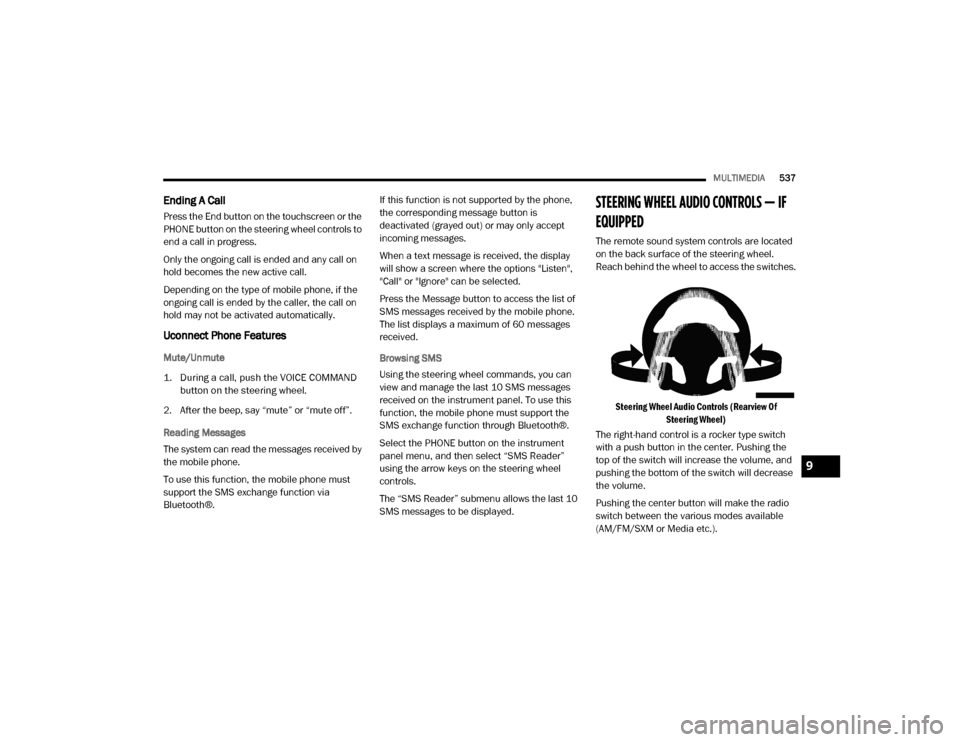remote control Ram 3500 2020 User Guide
[x] Cancel search | Manufacturer: RAM, Model Year: 2020, Model line: 3500, Model: Ram 3500 2020Pages: 568
Page 275 of 568

STARTING AND OPERATING273
(Continued)
(Continued)
OPERATING YOUR WINCH General Information
Practice using your winch before you get stuck.
Some key points to remember when using your
winch are:
Always take your time to assess the situation
and plan your pull carefully.
Always take your time when using a winch.
Use the right equipment for the situation.
Always wear leather gloves and do not allow
the synthetic rope to slip through your hands
when handling the rope.
Only the operator should handle the synthetic
rope and remote control.
Think safety at all times.
Vehicle Recovery Using The Winch
WARNING!
Failure to observe any of these warnings
regarding proper winch usage may result in
severe injury.
Always use supplied hook strap to hold the
hook when spooling wire rope in or out.
Never use as a hoist.
Never use to move persons.
Never exceed winch or synthetic rope rated
capacity.
Always wear heavy leather gloves when
handling the synthetic rope.
Never touch synthetic rope or hook while in
tension or under load.
Never engage or disengage clutch if winch
is under load, synthetic rope is in tension,
or rope drum is moving.
Always stand clear of synthetic rope and
load and keep others away during winching.
Always keep hands and clothing clear of the
synthetic rope, hook and fairlead opening
during operation and when spooling.
Never wrap synthetic rope back onto itself.
Always use a choker chain, wire choker
rope or tree trunk protector on the anchor.
Never attach a recovery strap to the winch
hook to increase the length of a pull.
Never attempt to tow a vehicle with the
recovery strap attached directly to the
winch hook.
Never use bungee or kinetic straps that
develop tremendous and potentially
dangerous amounts of force when
stretched.
Always disconnect the remote control when
not in use.
Never winch when there are less than
10 wraps of synthetic rope around the
winch drum.
Always pass remote control through a
window to avoid pinching lead in door,
when using remote inside a vehicle.
Never leave the remote control plugged
into the winch while free spooling, rigging or
sitting idle.
WARNING! (Continued)
CAUTION!
Always know your winch: Take the time to
fully read and understand the included
Installation and Operations Guide, and
Basic Guide to Winching Techniques, in
order to understand your winch and the
winching operation.
5
20_DJD2_OM_EN_USC_t.book Page 273
Page 276 of 568

274STARTING AND OPERATING
1. Inspect the winch, winch mount, and
synthetic rope for damage. Do not use the
winch if the mount is loose or rope shows
excessive wear, frays, or damage.
Winch Rope
2. Put on gloves.
3. Disengage the clutch to allow free spooling of the winch drum, rotate the clutch lever on
the winch to disengage. Freespooling
conserves battery power.
Free Spool Lever
4. Free the winch hook and attach the hook strap. Free the winch hook from its anchor
point. Attach the hook strap to the hook (if
not attached).
Hook Strap
Always inspect winch installation and
synthetic rope condition before operating
the winch. Frayed, kinked or damaged rope
must be replaced immediately. Loose or
damaged winch installation must be
corrected immediately.
Always be sure any element which can
interfere with safe winching operations is
removed prior to initiating winching.
Always keep remote control lead clear of
the drum, synthetic rope and rigging.
Inspect for cracks, pinches, frayed rope, or
loose connections. Replace if damaged.
Be careful not to pull the winch rope collar
through the rollers. Watch and listen to
winch for proper snugness.
Never power hook through fairlead. Could
cause damage.
CAUTION! (Continued)
20_DJD2_OM_EN_USC_t.book Page 274
Page 278 of 568

276STARTING AND OPERATING
9. Connect the remote control to the winch
control box, located on the front bumper. Be
careful not to let the remote control cord
dangle in front of the winch. If you choose to
control the winch from inside your vehicle,
always pass the remote through a window
to avoid pinching the cord in the door.
Always disconnect the remote control when
not in use.
Winch Box Remote Control Connector
10. Put synthetic rope under tension. Using the remote control switch, slowly wind the rope
until no slack remains. Once the rope is
under tension, stand well clear of it and
never step over it.
Pulling Synthetic Rope Under Tension
11. Check your anchor. Make sure all connections are secured and free of debris
before continuing with the winching
procedure.
12. Check synthetic rope. The rope should be neatly wound around the spooling drum.
Improper winding can cause damage to the
synthetic rope.
Synthetic Rope Neatly Wound Around
The Spooling Drum
Heavy Blanket Over Rope
20_DJD2_OM_EN_USC_t.book Page 276
Page 279 of 568

STARTING AND OPERATING277
In certain situations you may decide to
throw a heavy blanket or similar object over
the rope. A heavy blanket can absorb ener -
gy should the synthetic rope break. Place it
on the rope midway between the winch and
the anchor point. Do this before the rope is
put under tension. Do not approach or move
the blanket once tension is applied. Do not
allow it to get pulled into the fairlead. If it is
necessary to move or remove the blanket,
slack the tension on the rope first.
13. Establish "no people" zones: Make your
intentions clear. Be sure that everyone in
the immediate vicinity surrounding the
winching operation is completely aware of
your intentions before you pull. Declare
where the spectators should not stand —
never behind or in front of the vehicle and
never near the synthetic rope or snatch
block. Your situation may have other "no
people" zones.
No People Zones
14. Begin winching. With the winching vehicles engine on and light tension already on the
synthetic rope, begin winching slowly and
steadily. Be sure that the rope is winding
evenly and tightly around the spooling
drum. For additional assistance, the
winched vehicle can be slowly driven while
being pulled by the winch. Continue pulling
until the vehicle is on stable ground. If you
are able to drive the vehicle, the winching
operation is complete.
Using The Remote Control
NOTE:
Avoid overheating the winch motor. For
extended winching, stop at reasonable inter -
vals to allow the winch motor to cool down.
What to look for under load: The synthetic
rope must always spool onto the drum as
indicated by the drum rotation decal on the
winch. As you power-in, make sure the
synthetic rope winds evenly and tightly on the
drum. This prevents the outer rope wraps
from drawing into the inner wraps, binding
and damaging the synthetic rope. Avoid
shock loads by using the control switch inter -
mittently to take up rope slack. Shock loads
can momentarily far exceed the winch and
synthetic rope ratings. During side pulls the
5
20_DJD2_OM_EN_USC_t.book Page 277
Page 280 of 568

278STARTING AND OPERATING
synthetic rope tends to stack up at one end of
the drum. This stack can become large
enough to cause serious damage to the
winch. So, line up pulls as straight ahead as
possible and stop winching if the synthetic
rope comes close to the tie rods or mounting
plate. To fix an uneven stack, spool out that
section of the rope and reposition it to the
opposite end of the drum, which will free up
space for continued winching.
15. Secure vehicle. Once recovery of the vehicle is complete, be sure to secure the vehicle's
brakes and shift the transmission to PARK.
Release tension in the synthetic rope.
16. Disconnect the synthetic rope, and disconnect from the anchor.
17. Rewind the synthetic rope. The person handling the synthetic rope should walk the
rope in and not let it slide through the hand,
control the winch at all times.
Rewinding The Synthetic Rope
NOTE:
How to spool under no load: Arrange the remote
control lead so it cannot be caught in the winch.
Arrange the synthetic rope so it will not kink or
tangle when spooled. Be sure any synthetic
rope already on the spooling drum is wound
tightly and evenly layered. Tighten and
straighten the layer if necessary. Keep the
synthetic rope under light tension and spool the
rope back and onto the winch drum in even
layers. Stop frequently to tighten and straighten
the layers as necessary. Repeat this process until the winch hook is the same distance as the
full length of the remote control from the winch.
Pinch the hook between your thumb and fore
-
finger and attach the hook strap. Hold the hook
strap between the thumb and forefinger to keep
tension on the synthetic rope. Walk the
synthetic rope towards the fairlead, carefully
spooling in the remaining rope by pulsing the
remote control switch.
18. Store the hook on the most outboard loop of
the hawse fairlead.
Hook In Stored Position
19. Disconnect the remote control. Disconnect the remote control cord from the control box
and store in a clean and dry place. Winching
operations are now complete. Put the cap
on the solenoid plug-in.
WARNING!
To prevent serious injury, NEVER put your
fingers inside the hook area as you are
powering-in.
20_DJD2_OM_EN_USC_t.book Page 278
Page 281 of 568

STARTING AND OPERATING279
NOTE:
Always store the remote control in a protected,
clean, dry area.
RIGGING TECHNIQUES
Various winching situations will require
application of other winching techniques. These
could range from too little distance to achieve
maximum pull using straight line rigging, simply
increasing pulling power, or maintaining a
straight-line pulling situation. You will have to
assess what technique is correct for your
situation. Think "safety" at all times.
How To Change The Pulling Direction
Change Pulling Directions
All winching operations should have a straight
line from the winch to the object being pulled. This minimizes the synthetic rope collecting on
one side of the drum affecting pulling efficiency
and damaging synthetic rope. A snatch block,
secured to a point directly in front of the vehicle
will enable you to change your pulling direction
while still allowing the synthetic rope to be at
90° to wind properly onto the spooling drum.
Increasing Pulling Power
In some cases, you may find yourself needing
more pulling power. The use of snatch blocks
increases mechanical advantage and that
increases your pulling power.
Double Line
Wire Rope Routing
Because pulling power decreases with the
number of layers of synthetic rope on the winch drum, you can use a snatch block to double line
out more rope. This decreases the number of
layers of synthetic rope on the drum, and
increases pulling power. Start by feeding out
enough synthetic rope to free the winch hook.
Attach the hook to your vehicle's frame/tow
hook and run the rope through a snatch block.
Disengage the clutch and, using the snatch
block, pull out enough synthetic rope to reach
your anchor point. Do not attach the hook to the
mounting kit. Secure to the anchor point with a
tree trunk protector or choker chain. Attach the
clevis/shackle. Attach the shackle to the two
ends of the strap/chain, being careful not to
over tighten (tighten and back-off 1/2 turn).
FUEL SAVER TECHNOLOGY — GAS ENGINE
(IF EQUIPPED)
This feature offers improved fuel economy by
shutting off four of the engine's eight cylinders
during light load and cruise conditions. The
system is automatic with no driver inputs or
additional driving skills required.
NOTE:
This system may take some time to return to full
functionality after a battery disconnect.
5
20_DJD2_OM_EN_USC_t.book Page 279
Page 539 of 568

MULTIMEDIA537
Ending A Call
Press the End button on the touchscreen or the
PHONE button on the steering wheel controls to
end a call in progress.
Only the ongoing call is ended and any call on
hold becomes the new active call.
Depending on the type of mobile phone, if the
ongoing call is ended by the caller, the call on
hold may not be activated automatically.
Uconnect Phone Features
Mute/Unmute
1. During a call, push the VOICE COMMAND
button on the steering wheel.
2. After the beep, say “mute” or “mute off”.
Reading Messages
The system can read the messages received by
the mobile phone.
To use this function, the mobile phone must
support the SMS exchange function via
Bluetooth®. If this function is not supported by the phone,
the corresponding message button is
deactivated (grayed out) or may only accept
incoming messages.
When a text message is received, the display
will show a screen where the options "Listen",
"Call" or "Ignore" can be selected.
Press the Message button to access the list of
SMS messages received by the mobile phone.
The list displays a maximum of 60 messages
received.
Browsing SMS
Using the steering wheel commands, you can
view and manage the last 10 SMS messages
received on the instrument panel. To use this
function, the mobile phone must support the
SMS exchange function through Bluetooth®.
Select the PHONE button on the instrument
panel menu, and then select “SMS Reader”
using the arrow keys on the steering wheel
controls.
The “SMS Reader” submenu allows the last 10
SMS messages to be displayed.
STEERING WHEEL AUDIO CONTROLS — IF
EQUIPPED
The remote sound system controls are located
on the back surface of the steering wheel.
Reach behind the wheel to access the switches.
Steering Wheel Audio Controls (Rearview Of Steering Wheel)
The right-hand control is a rocker type switch
with a push button in the center. Pushing the
top of the switch will increase the volume, and
pushing the bottom of the switch will decrease
the volume.
Pushing the center button will make the radio
switch between the various modes available
(AM/FM/SXM or Media etc.).
9
20_DJD2_OM_EN_USC_t.book Page 537
Page 558 of 568

556 J
Jack Location
................................................. 365Jump Starting................................................ 375
K
Key Fob Panic Alarm
................................................. 15Programming Additional Key Fobs....... 16, 24Key Fob Battery Service (Remote
Keyless Entry).................................................. 15
Key Fob Programming (Remote Keyless Entry).. 16
Keyless Enter-N-Go........................28, 214, 218Lock The Vehicle’s Doors....... 476, 494, 514Passive Entry............................................... 28Passive Entry Programming............. 494, 514Keys................................................................. 14Replacement............................................... 24
L
Lane Change And Turn Signals........................ 51Lane Change Assist......................................... 52LaneSense.................................................... 306Latches.......................................................... 212Hood........................................................... 74Lead Free Gasoline........................................ 454Leaks, Fluid................................................... 212Life Of Tires................................................... 439Light Bulbs........................................... 212, 351
Lights............................................................ 212Air Bag.................................... 130, 182, 210Automatic High Beam.................................. 49Brake Assist Warning............................... 148Brake Warning.......................................... 131Bulb Replacement.................................... 351Cab Top Clearance................................... 357Cargo........................................................... 52Center Mounted Stop............................... 356Courtesy/Reading....................................... 53Cruise....................................................... 141Daytime Running......................................... 49
Electronic Stability Program(ESP) Indicator... 132
Exterior...............................................48, 212Fog........................................................... 355Four Wheel Drive Indicator....................... 255Hazard Warning Flasher........................... 346Headlights............................................ 48, 50High Beam................................................... 49Hill Descent Control Indicator................... 149Illuminated Entry......................................... 54Interior......................................................... 53Lights On Reminder..................................... 51Low Fuel................................................... 135Malfunction Indicator (Check Engine)....... 133Park.......................................................... 140Passing........................................................ 50Seat Belt Reminder.................................. 130Security Alarm.......................................... 132Service..................................................... 351
Side Marker.............................................. 357Traction Control........................................ 148Transfer Case........................................... 255Turn Signals............51, 141, 212, 353, 355Warning Instrument Cluster Descriptions................................ 132, 141Limited-Slip Differential....................... 270, 424Load Shed Battery Saver Mode..................... 129Load Shed Battery Saver On......................... 129Load Shed Electrical Load Reduction........... 129Load Shed Intelligent Battery Sensor............ 129Loading Vehicle............................................. 324Tires.......................................................... 433LocksAutomatic Door............................................30Child Protection...........................................30Power Door..................................................27Low Tire Pressure System............................. 163Lubrication, Body.......................................... 414Lug Nuts/Bolts.............................................. 452
M
Maintenance....................................................73Maintenance Free Battery............................ 400Maintenance Plan......................................... 391Maintenance Schedule............... 385, 389, 391Malfunction Indicator Light
(Check Engine)..................................... 133, 143
20_DJD2_OM_EN_USC_t.book Page 556